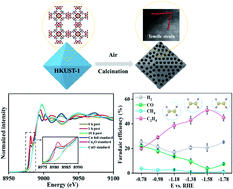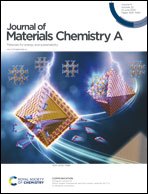Metal–organic framework derived copper catalysts for CO2 to ethylene conversion†
Abstract
The electrochemical reduction of CO2 to ethylene provides a carbon-neutral avenue for the conversion of CO2 to value-added fuels and feedstocks, so contributing to the storage of intermittent renewable electricity. The exploration of efficient electrocatalysts with high ethylene selectivity and productivity is highly desirable but remains challenging. Here, we present a Cu-based catalyst derived from a metal–organic framework (Cu-MOF) which shows enhanced performance due to its porous morphology, complex oxidation states and strong lattice strain. X-ray diffraction, X-ray photoelectron spectroscopy, and X-ray absorption spectroscopy are utilized to track the evolution of the crystal structure and oxidation states during the reaction, and the results reveal that Cu2+ ions are rapidly reduced to Cu+ and then slowly to Cu0, resulting in a Cu@CuxO core@shell structure. The tensile strain caused by the distorted grain is beneficial for the activation of CO2. Cu+/Cu0 interfaces formed through stabilized Cu+ facilitate *CO–CO dimerization, promoting conversion to C2+ products and suppressing conversion to C1 products. The optimized catalyst exhibits a 51% Faraday efficiency (FE) for ethylene and a 70% FE for C2+ products, with 20 h operational stability in an H-cell configuration, and a partial ethylene current density of 150 mA cm−2 in a flow-cell configuration.

- This article is part of the themed collection: Journal of Materials Chemistry A HOT Papers


 Please wait while we load your content...
Please wait while we load your content...